Abstract
STUDY OBJECTIVE--The aim was to compare four different measures of women's social class (interview and census based) as predictors of well known social gradients in reproductive outcomes. The intent was to address two obstacles that confront research in the United States regarding social gradients in women's health: how women's social class should be measured, and the absence of socioeconomic data in most health records. STUDY DESIGN--The study was a retrospective cohort analysis, using a community based random sample. Setting--Alameda County, California, 1987. SUBJECTS--51 black and 50 white women, ages 20 to 80 years, identified by random digit dialling, were interviewed by telephone. MEASUREMENTS AND MAIN RESULTS--Census data were linked to individual records via the respondents' addresses. Using number of full term pregnancies as an example, multiple linear regression analyses demonstrated that individual class was not significantly associated with this outcome, whereas household class was: women from non-working-class households had 0.8 fewer such pregnancies than women from working class households (95% confidence interval [CI] = -1.4, -0.1). The block group measure functioned most like the household class measure (beta = -0.7, 95% CI = -1.4, 0.1), while the census tract measure was non-significant (beta = -0.4, 95% CI = -1.2, 0.4). Similar results were obtained for the outcomes: age at first full term pregnancy, percent of early terminated pregnancies, and yearly income. CONCLUSIONS--These results suggest block group data may offer a uniform source of social class information that can be appended to individual health records, and that this strategy is not invalidated by concerns regarding ecological fallacy.
Full text
PDF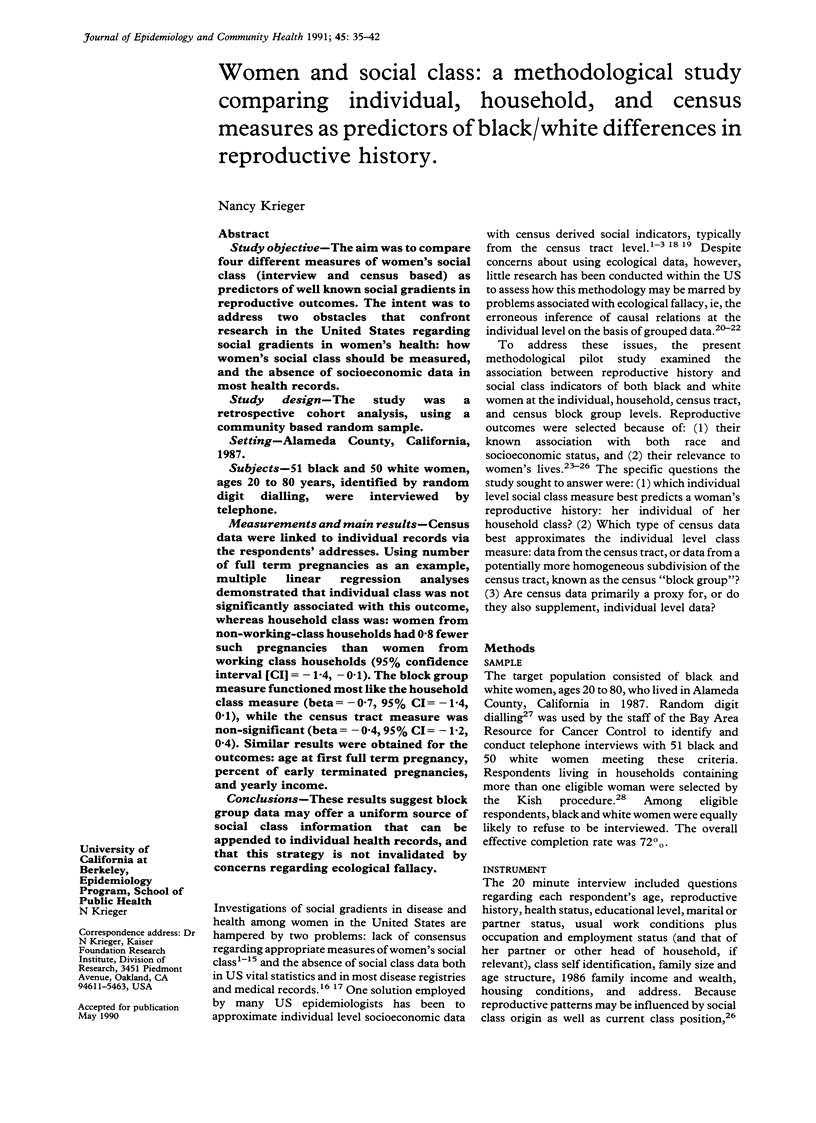
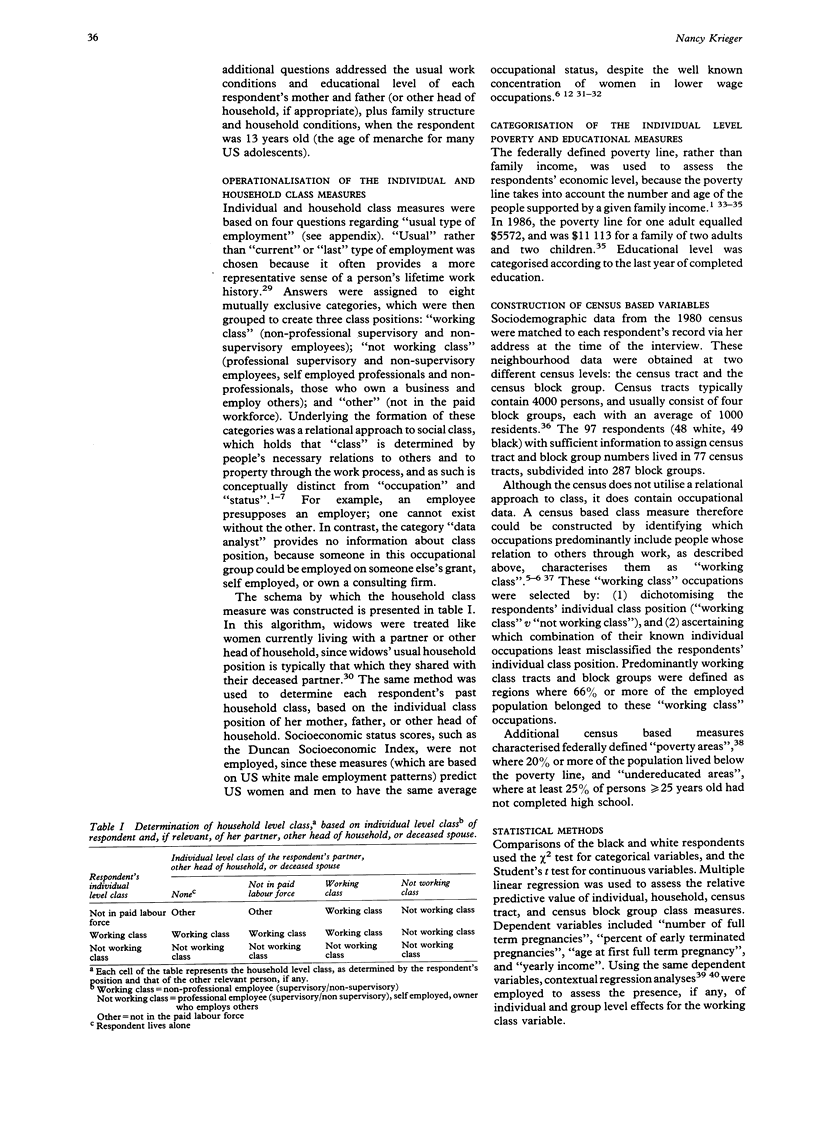
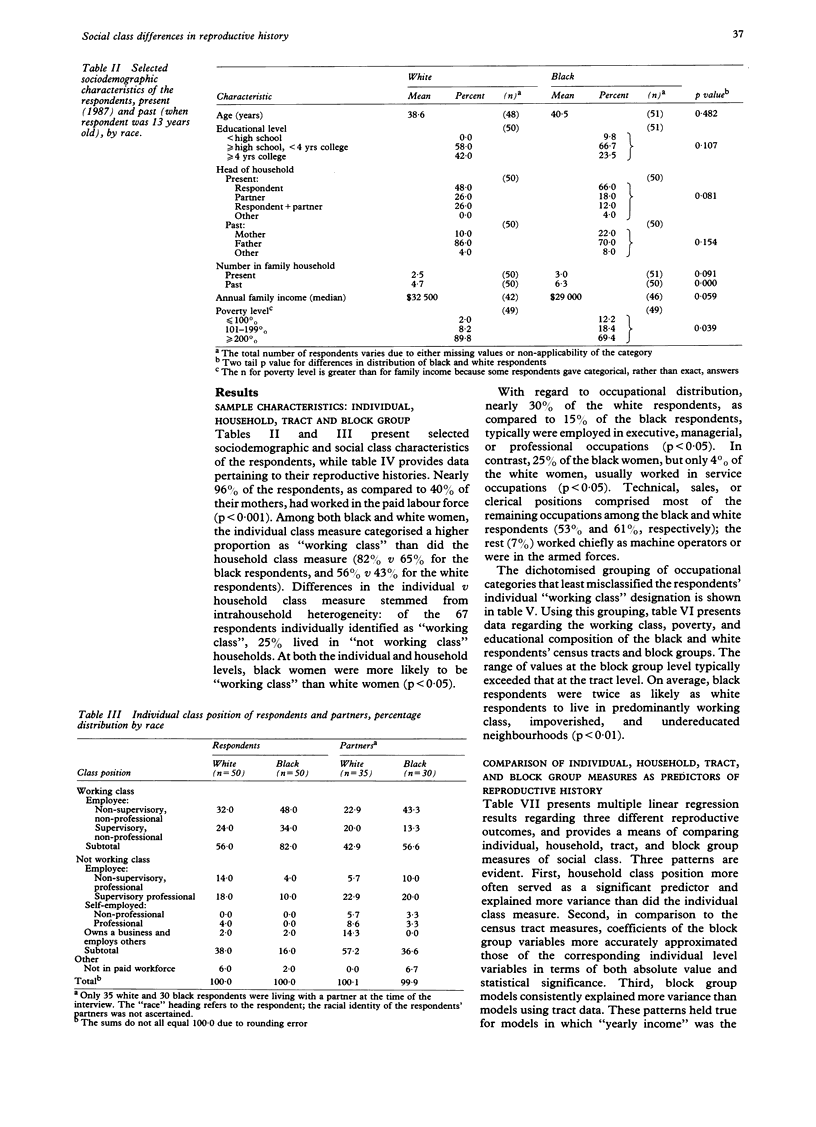
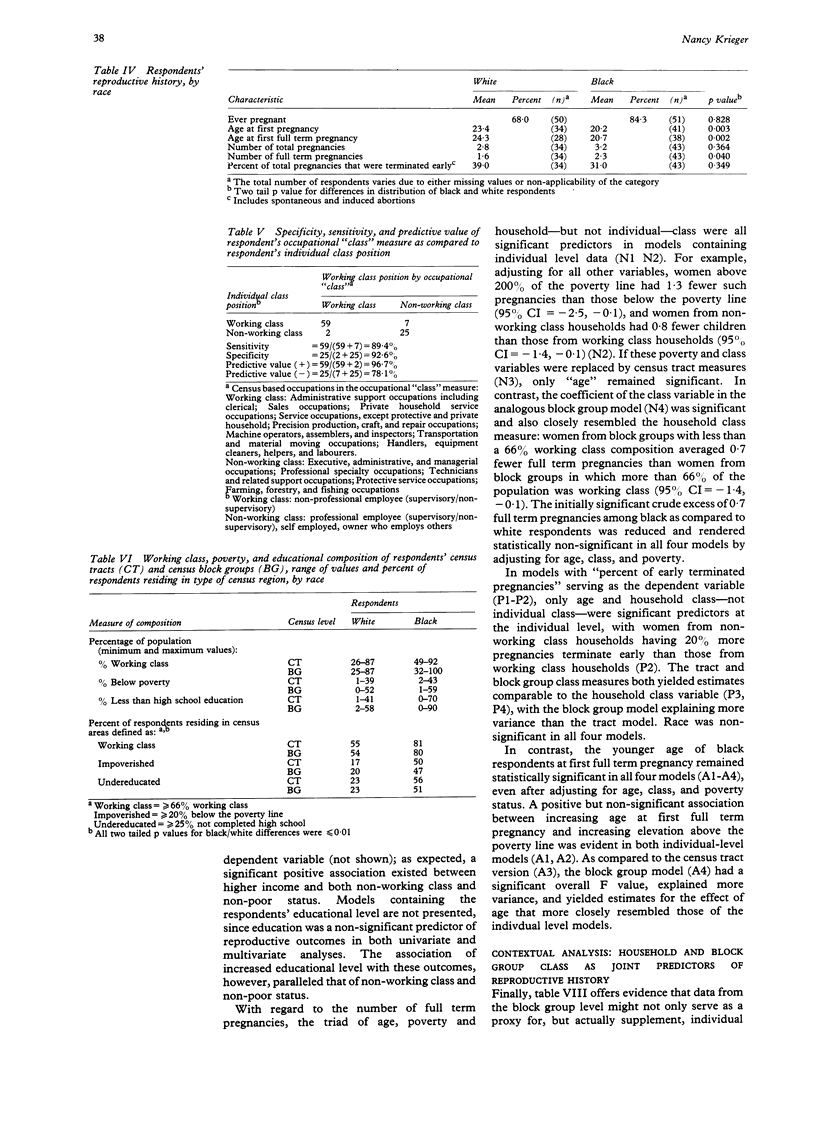
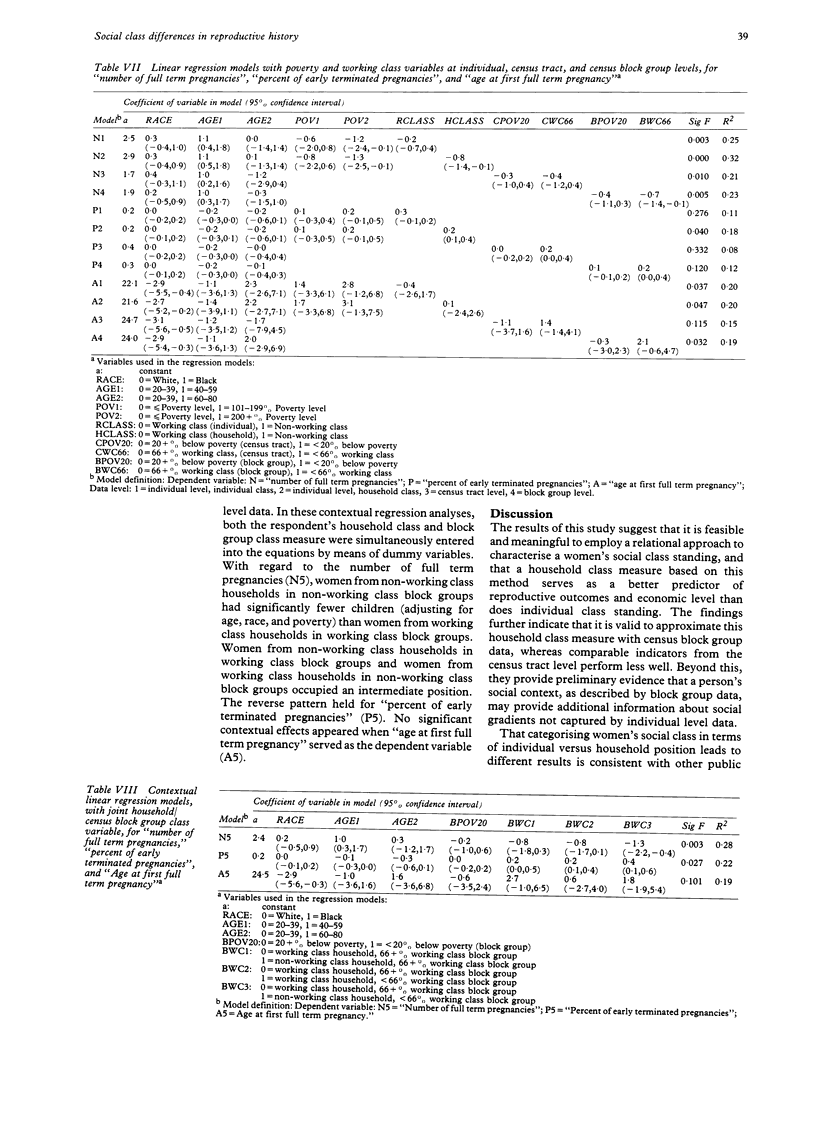



Selected References
These references are in PubMed. This may not be the complete list of references from this article.
- Alexander F. E., O'Brien F., Hepburn W., Miller M. Association between mortality among women and socioeconomic factors in general practices in Edinburgh: an application of small area statistics. Br Med J (Clin Res Ed) 1987 Sep 26;295(6601):754–756. doi: 10.1136/bmj.295.6601.754. [DOI] [PMC free article] [PubMed] [Google Scholar]
- Arber S. Social class, non-employment, and chronic illness: continuing the inequalities in health debate. Br Med J (Clin Res Ed) 1987 Apr 25;294(6579):1069–1073. doi: 10.1136/bmj.294.6579.1069. [DOI] [PMC free article] [PubMed] [Google Scholar]
- Bassett M. T., Krieger N. Social class and black-white differences in breast cancer survival. Am J Public Health. 1986 Dec;76(12):1400–1403. doi: 10.2105/ajph.76.12.1400. [DOI] [PMC free article] [PubMed] [Google Scholar]
- Haan M., Kaplan G. A., Camacho T. Poverty and health. Prospective evidence from the Alameda County Study. Am J Epidemiol. 1987 Jun;125(6):989–998. doi: 10.1093/oxfordjournals.aje.a114637. [DOI] [PubMed] [Google Scholar]
- Harlow S. D., Linet M. S. Agreement between questionnaire data and medical records. The evidence for accuracy of recall. Am J Epidemiol. 1989 Feb;129(2):233–248. doi: 10.1093/oxfordjournals.aje.a115129. [DOI] [PubMed] [Google Scholar]
- Hartge P., Brinton L. A., Rosenthal J. F., Cahill J. I., Hoover R. N., Waksberg J. Random digit dialing in selecting a population-based control group. Am J Epidemiol. 1984 Dec;120(6):825–833. doi: 10.1093/oxfordjournals.aje.a113955. [DOI] [PubMed] [Google Scholar]
- Illis W. R., Swanson G. M., Satariano E. R., Schwartz A. G. Summary measures of occupational history: a comparison of latest occupation and industry with usual occupation and industry. Am J Public Health. 1987 Dec;77(12):1532–1534. doi: 10.2105/ajph.77.12.1532. [DOI] [PMC free article] [PubMed] [Google Scholar]
- Karasek R. A., Theorell T., Schwartz J. E., Schnall P. L., Pieper C. F., Michela J. L. Job characteristics in relation to the prevalence of myocardial infarction in the US Health Examination Survey (HES) and the Health and Nutrition Examination Survey (HANES). Am J Public Health. 1988 Aug;78(8):910–918. doi: 10.2105/ajph.78.8.910. [DOI] [PMC free article] [PubMed] [Google Scholar]
- Krieger N. Social class and the black/white crossover in the age-specific incidence of breast cancer: a study linking census-derived data to population-based registry records. Am J Epidemiol. 1990 May;131(5):804–814. doi: 10.1093/oxfordjournals.aje.a115571. [DOI] [PubMed] [Google Scholar]
- Liberatos P., Link B. G., Kelsey J. L. The measurement of social class in epidemiology. Epidemiol Rev. 1988;10:87–121. doi: 10.1093/oxfordjournals.epirev.a036030. [DOI] [PubMed] [Google Scholar]
- Morgan M., Chinn S. ACORN group, social class, and child health. J Epidemiol Community Health. 1983 Sep;37(3):196–203. doi: 10.1136/jech.37.3.196. [DOI] [PMC free article] [PubMed] [Google Scholar]
- Morgan M. Measuring social inequality: occupational classifications and their alternatives. Community Med. 1983 May;5(2):116–124. [PubMed] [Google Scholar]
- Morgenstern H. Uses of ecologic analysis in epidemiologic research. Am J Public Health. 1982 Dec;72(12):1336–1344. doi: 10.2105/ajph.72.12.1336. [DOI] [PMC free article] [PubMed] [Google Scholar]
- Rose G. Sick individuals and sick populations. Int J Epidemiol. 1985 Mar;14(1):32–38. doi: 10.1093/ije/14.1.32. [DOI] [PubMed] [Google Scholar]
- Selvin S. Two issues concerning the analysis of grouped data. Eur J Epidemiol. 1987 Sep;3(3):284–287. doi: 10.1007/BF00149737. [DOI] [PubMed] [Google Scholar]
- Syme S. L. Social epidemiology and the work environment. Int J Health Serv. 1988;18(4):635–645. doi: 10.2190/LLYB-QCND-G5VB-JP9Y. [DOI] [PubMed] [Google Scholar]
- Tilley B. C., Barnes A. B., Bergstralh E., Labarthe D., Noller K. L., Colton T., Adam E. A comparison of pregnancy history recall and medical records. Implications for retrospective studies. Am J Epidemiol. 1985 Feb;121(2):269–281. doi: 10.1093/oxfordjournals.aje.a113997. [DOI] [PubMed] [Google Scholar]
- Westermeyer J. Problems with surveillance methods for alcoholism: differences in coding systems among federal, state, and private agencies. Am J Public Health. 1988 Feb;78(2):130–133. doi: 10.2105/ajph.78.2.130. [DOI] [PMC free article] [PubMed] [Google Scholar]
- Wilcox A. J., Horney L. F. Accuracy of spontaneous abortion recall. Am J Epidemiol. 1984 Nov;120(5):727–733. doi: 10.1093/oxfordjournals.aje.a113940. [DOI] [PubMed] [Google Scholar]


